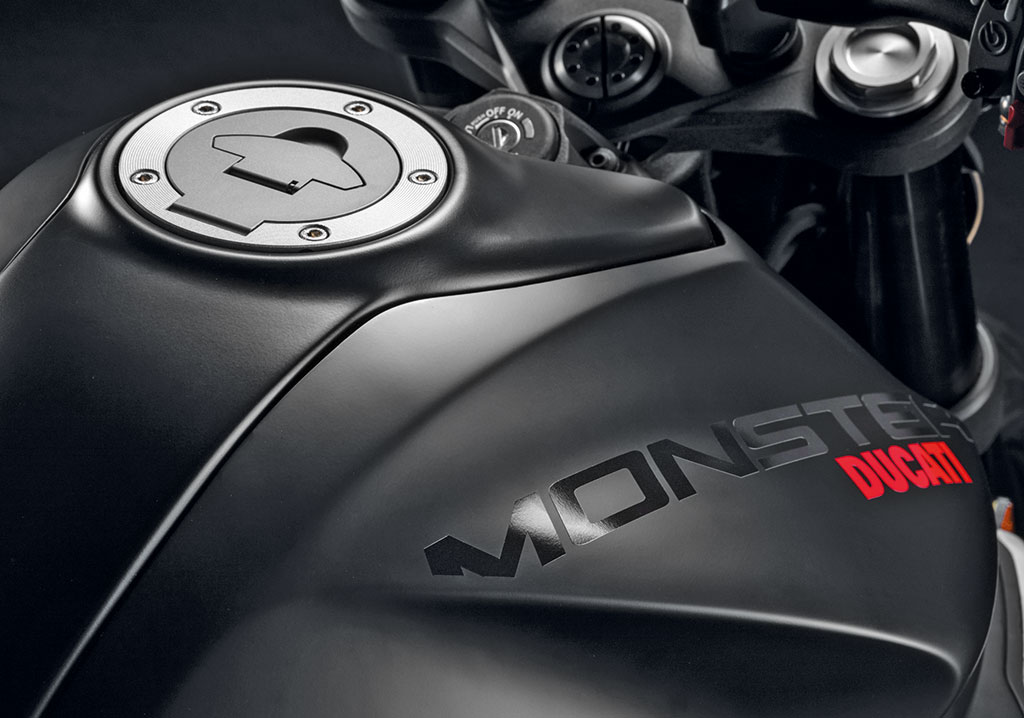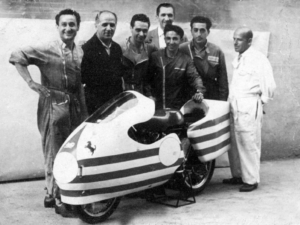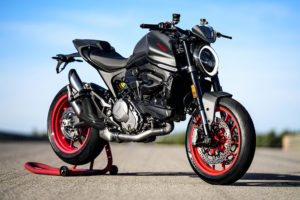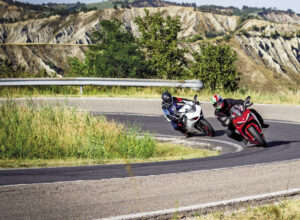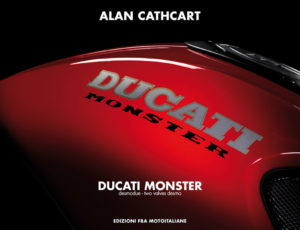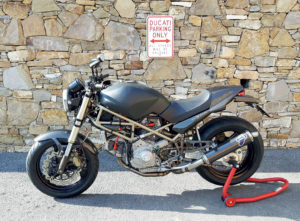Appena presentato è stato subito un apriti cielo; sui social i vari commentatori si sono scatenati e il commento più gentile, beh, non lo possiamo ripetere qui! Il motivo del contendere è ovviamente la nuova proposta Ducati in tema di Monster, con la presentazione di un nuovo modello che, in un colpo solo, sostituisce le versioni 797 e 821.
Ma come mai tanto astio? Probabilmente è il risultato finale di una sorta di reazione a catena, innescata certamente dal motore V4 senza il Desmo; dopo questa prima bella botta alle convinzioni ducatiste, ecco la seconda: un nuovo Monster che si distanzia nettamente dal passato; tanto per dire, addio al telaio a traliccio ed ecco un front frame in alluminio!
Inaudito!
L’effetto è stato un po’ come quello che si crea quando si mettono in dubbio quei due/tre capisaldi che sembrano tenere insieme le nostre convinzioni o credenze; il mondo ti crolla addosso.
Poi, diciamocelo, noi ducatisti siamo un po’ conservatori: la moto più bella è quella che non c’è più, il modello di prima, perché quello di oggi, no, non va proprio bene! Per chi ha un po’ di memoria storica, successe così addirittura con la 916, con tanti nostalgici a rimpiangere 851 e 888!
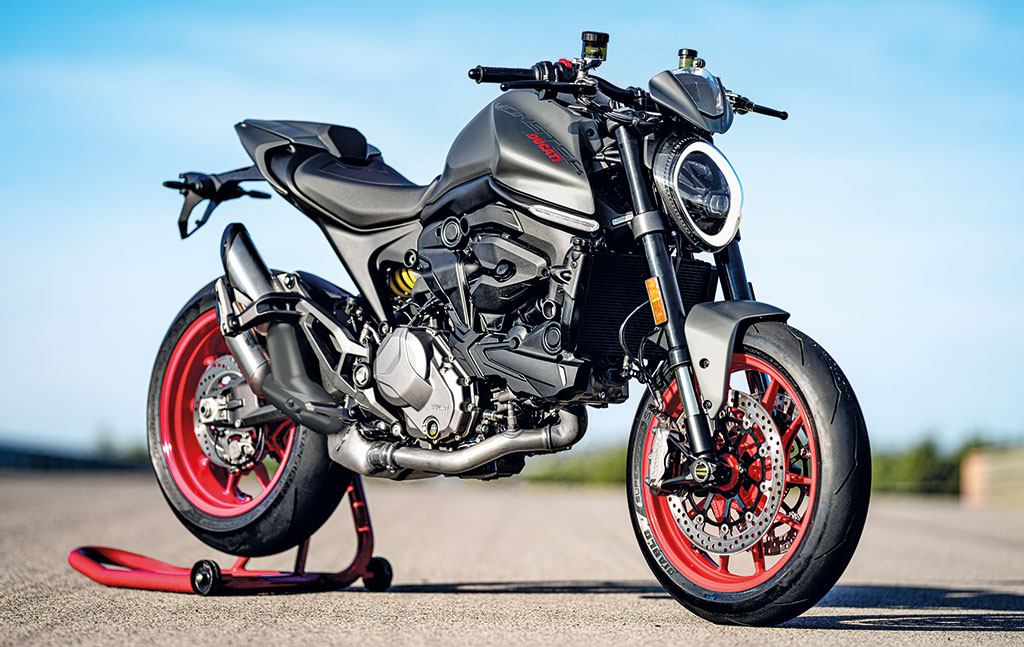
Anche il Monster del 1993 all’inizio fece inorridire non poco gli appassionati duri e puri, quelli delle coppie coniche, che avevano la mano sinistra d’acciaio per gestire una leva della frizione dura come un ossesso.
Comunque, sia chiaro, quando ho visto il nuovo Monster ci sono rimasto male anch’io! Per capire che è una Ducati bisogna concentrarsi sulla scritta sul serbatoio, mentre con il Monster, storicamente, non serviva, tanto che per alcuni anni fu anche tolto ogni logo dalla moto: era un Monster, perbacco, lo si vedeva benissimo!
Insomma, la moto mi è sembrata anonima, troppo simile alla concorrenza, forse colpa di quel faro che me la fa somigliare troppo alla Brutale? Però, diciamolo chiaramente, questi sono abbastanza fatti miei, nel senso che quello che non piace a me può invece andare a genio a molti altri.
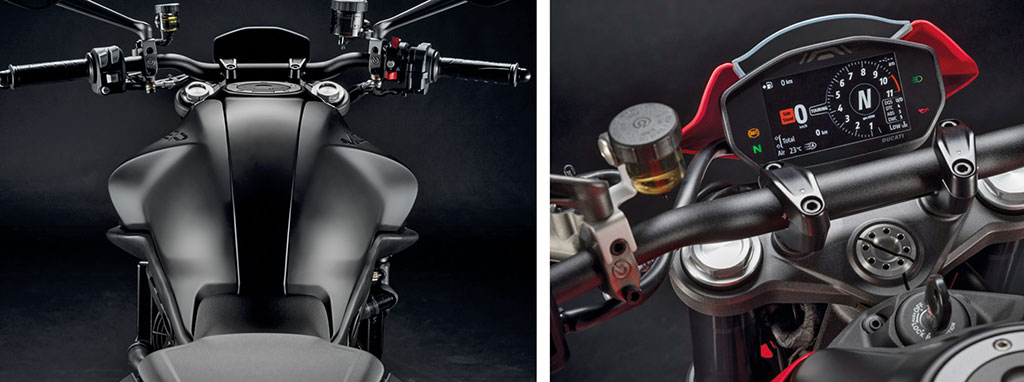
Però, come la mettiamo con la scomparsa dell’amatissimo telaio a traliccio, vero segno distintivo di Borgo Panigale?
Lasciando da parte nostalgia e gusti personali, leggendo la cartella stampa ci sono rimasto di stucco: il nuovo telaio, che riprende per forme e concetto quello della Panigale V4, pesa 4,5 Kg in meno, davvero tanta roba.
A ciò va poi aggiunto il chilo e nove del telaietto posteriore, ora costruito in uno speciale componente denominato GFRP (Glass Fiber Reinforced Polymer), e si arriva, se la matematica non mi inganna, a un risparmio che solo per la ciclistica è di ben 6,4 Kg.
Sarà anche meno iconico, come oggi si suol dire, del traliccio, ma la dieta è veramente importante, tanto che la moto ferma l’ago della bilancia a 188 kg in ordine di marcia: un grande risultato per una moto che comunque dispone di 111 Cv.
Detto così, sembrerebbe quindi un bel passo in avanti rispetto all’821, anche perché ai dati del telaio vanno aggiunte le riduzioni di peso derivanti da forcellone, motore (-2,4 Kg nonostante la sua cilindrata superiore )e cerchi; insomma, per farla breve sono 18 Kg in meno sempre rispetto al quattro valvole precedente!
A dire il vero, un’enormità che avrà sicuramente un riscontro sulla guidabilità del mezzo.
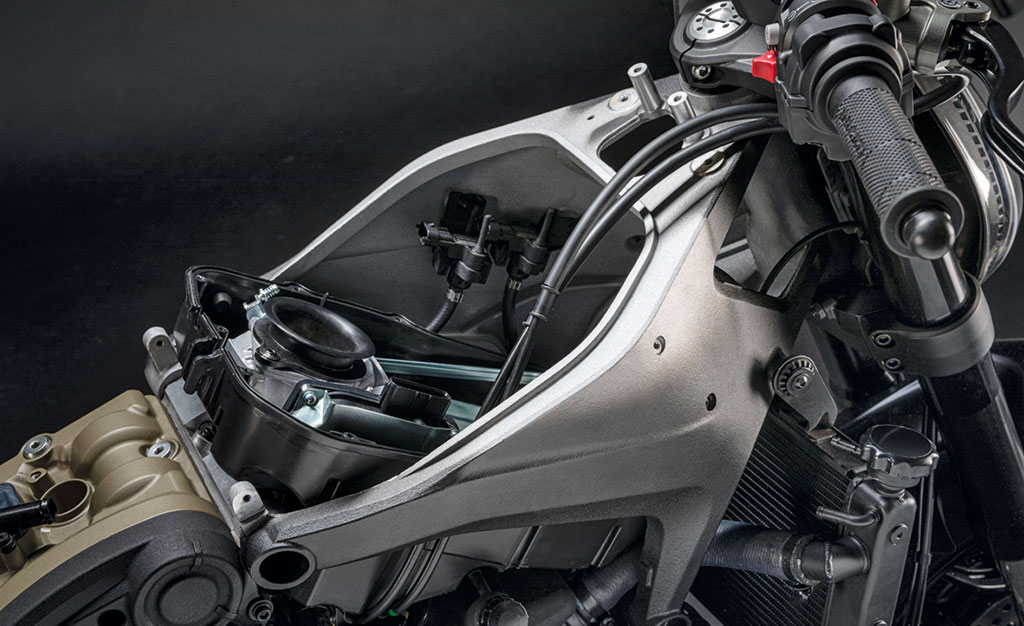
Sempre scorrendo la cartella stampa della nuova moto mi ha profondamente colpito un altro aspetto: questo monsterino ha la dotazione elettronica di una Panigale!
Non ci credete? Leggete qui: “Il comparto elettronico del Monster è ai vertici del segmento. La dotazione di serie comprende ABS Cornering, Traction Control, Wheelie Control, tutti regolabili su diversi livelli di intervento. Il carattere sportivo del nuovo Monster è sottolineato anche dal Launch Control che assicura partenze fulminee. Questa dotazione da moto top di gamma permette al Monster di esprimere in sicurezza le proprie performance.
I Riding Mode permettono di plasmare il carattere del Monster secondo i gusti e le necessità. Tutto è facilmente gestibile attraverso i comandi al manubrio e il cruscotto TFT a colori da 4,3” caratterizzato da una grafica racing che riprende quella della Panigale V4, con un grande contagiri al centro e, tra le altre, anche l’indicazione della marcia inserita”.
A tutto ciò va poi aggiunto anche il cambio elettronico di serie, sia in accelerazione che in scalata; dotazione di eccellenza per una moto che costa 11.290 euro, non poco in assoluto, ma, a mio parere, molto competitivo se si tiene conto di quanto offra il pacchetto.
Insomma, per farla breve, a me pare che in Ducati si siano abbastanza disinteressati del loro cliente tradizionale, puntando soprattutto, con questo Monster, a un nuovo pubblico, quello dei neofiti, di chi si avvicina per la prima volta al marchio e, perché no?, al pubblico femminile.
In effetti, come sicurezza attiva la moto è un bel po’ avanti rispetto alla concorrenza e poi ci sono molti altri dettagli che mi fanno pensare a questa particolare destinazione di utilizzo, come l’attenzione all’ergonomia e al comfort; il nuovo Monster, infatti, è basso di sella (820 mm con 70 mm di imbottitura), ha fianchi molto stretti per facilitare l’appoggio a terra di entrambi i piedi ed ha ridotto notevolmente il raggio di sterzata, soluzione ideale nell’impiego cittadino.
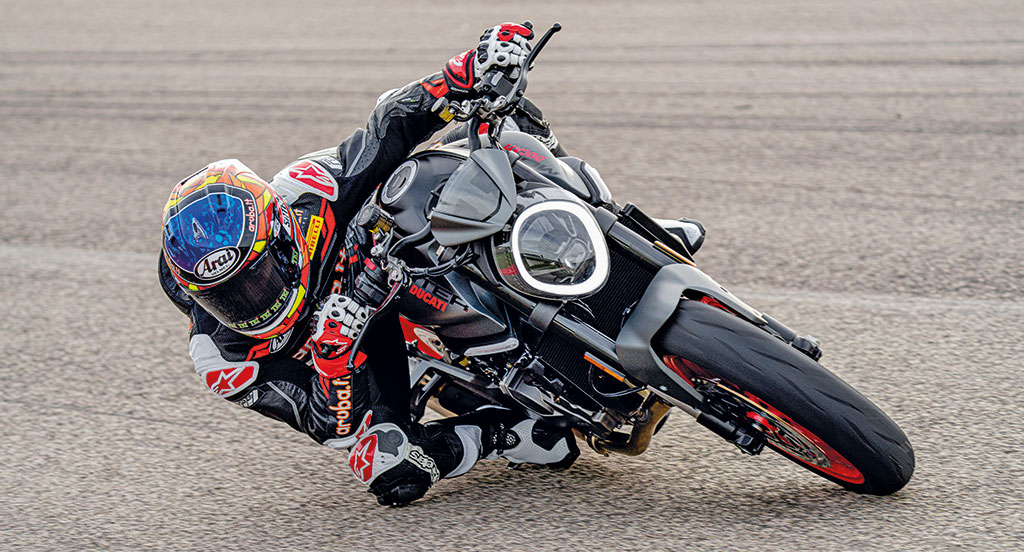
Infine, contribuisce anche il motore a mettere a proprio agio, con una coppia massima leggermente superiore, ma che arriva 1250 giri prima rispetto al motore 821, ovvero a régimi medio bassi, quelli più utilizzati su strada; infine, il carico richiesto per azionare la frizione è inferiore del 20% rispetto alla precedente versione.
Insomma, tanti indizi che mi fanno pensare come per il Monster si sia adottata la stessa logica della Multistrada V4, con il clamoroso abbandono del Desmo.
Anche in quel caso un chiaro segnale di come Ducati voglia abbandonare il suo orto per puntare su nuovi orizzonti, a tutti quei motociclisti che sono interessati ai vantaggi e alle caratteristiche del modello, ma che poco o nulla sanno di frizione a secco, telaio a traliccio e distribuzione Desmo.
Una scelta anche ovvia, se la pensiamo in termini di mercato, ma che dovrebbe invogliare anche noi ducatisti di vecchia data ad essere più pronti nell’accettare le novità e il fatto che comunque il mondo va avanti.
Poi basta con i preconcetti, i giudizi a priori, le convinzioni datate; le moto vanno sempre testate con attenzione prima di spendersi in giudizi affrettati, solo così si possono apprezzare i progressi della tecnica e dell’elettronica applicata alle due ruote.
Detto questo, scusate, termino qui perché in garage c’è il mio Monster 900 del 1995 pronto per un giro; è un tipo un po’ ignorante, meglio non farlo aspettare!
Il nuovo Monster in un colpo d’occhio
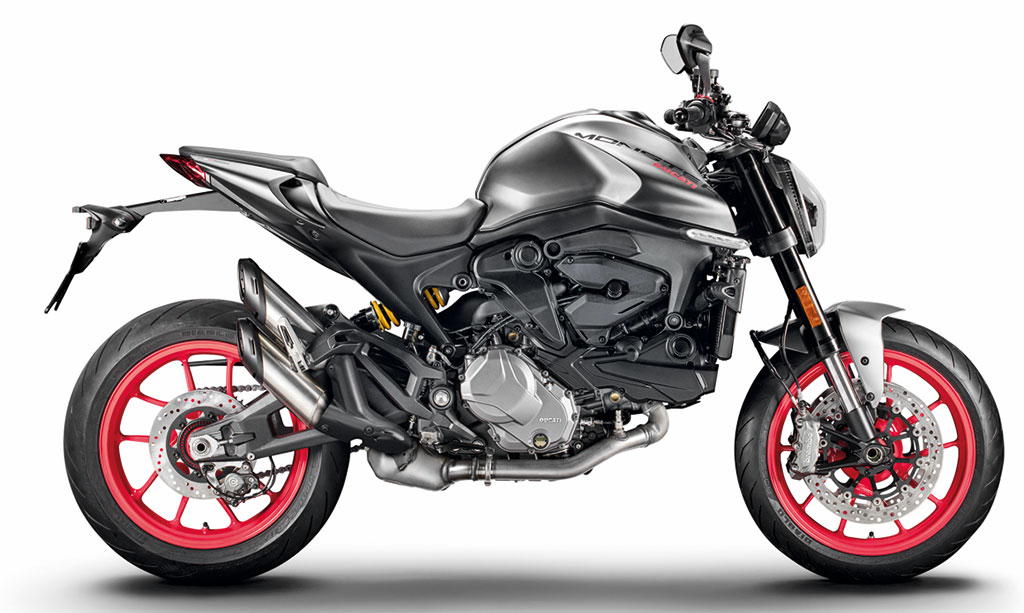
Colorazioni
Rosso Ducati con ruote nere
Aviator Grey con ruote rosse
Dark Stealth con ruote nere
Principali dotazioni
Motore Testastretta 11° da 937 cc
Omologazione Euro 5
Potenza massima 111 Cv a 9250 giri/minuto
Coppia massima 9,5 kgm a 6500 giri/minuto
Peso 166 kg a secco
Telaio front frame in alluminio
Telaietto posteriore in GFRP alleggerito
Forcellone di alluminio
Nuovo impianto luci Full LED con indicatori di direzione a tecnologia sweeping
Strumentazione TFT a colori da 4,3 pollici con indicazione marcia inserita e livello benzina
Riding Mode (3 configurazioni)
ABS Cornering regolabile su 3 livelli con modalità only front,
DTC e DWC regolabili su 8 livelli
Launch Control
Forcella a steli rovesciati da 43 mm di diametro
Ammortizzatore regolabile
Freni Brembo anteriori dischi da 320 mm con pinze M4.32 monoblocco pompa radiale e pastiglie realizzate in materiale sinterizzato
Frizione idraulica con pompa radiale
Altezza Sella 820 mm da terra, con sella ribassata opzionale 795 mm, con sella ribassata e kit sospensioni ribassate: 775 mm
DQS up/down
Prezzo: 11.290 Euro
Monster Plus
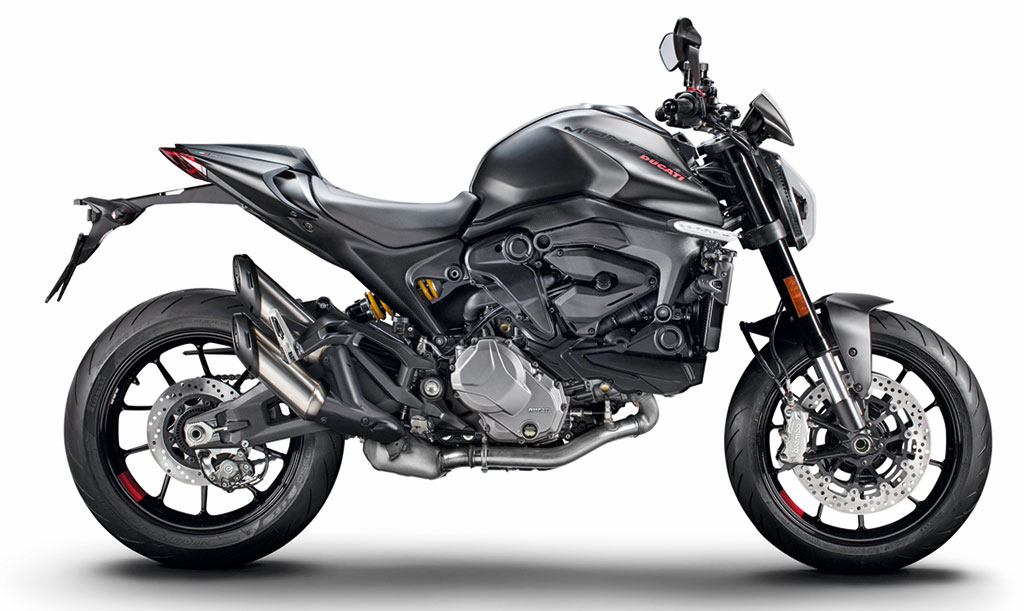
Dotazioni di serie come Monster ad eccezione di:
Cupolino
Cover sella passeggero
Prezzo: 11.590 Euro

SBK a Jerez: avanti tutta!
A Jerez de la Frontera, seconda tappa del campionato SBK, si ri-accende lo spettacolo con Ducati protagonista. Doppietta di Redding e secondo posto in gara 2 per Davies.
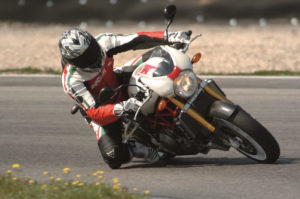
Prova in pista della Ducati Monster S4RS: un mostro di rabbia
Gian Maria Liverani ha messo alla frusta, sulla pista di Magione, la Ducati Monster S4RS.

